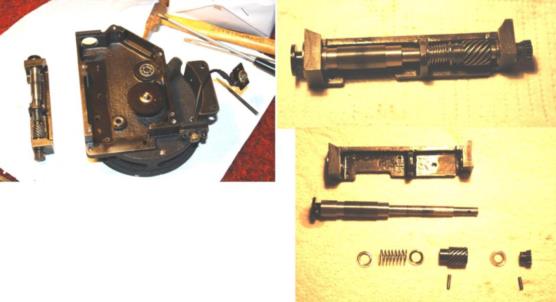
NavList:
A Community Devoted to the Preservation and Practice of Celestial Navigation and Other Methods of Traditional Wayfinding
Re: A-10 Sextant Manual
From: Douglas Denny
Date: 2009 Jun 10, 16:12 -0700
From: Douglas Denny
Date: 2009 Jun 10, 16:12 -0700
Bill, I have now disassembled the sextant again; and also the worm assembly. (pictures enclosed. I think I have the problem determined. If not actually solved in terms of curing it completely, I am fairly sure what the problem is: and it was as I expected some degree of end-float problem. With reference to the disassembled worm assembly: it immediately becomes clear that the bearings at both ends are plain bearings and the main worm/shaft is removed from the larger upper bearing hole. The shaft is free to move in either direction except for the stops which are the small gear at the bottom end acting against the washer of the lower end of the lower bearing stub, stopping it moving upwards; and the stop downwards is the change in diameter of the worm shaft at the upper side of the lower bearing onto the washer. The spring on the worm shaft, plus the spring of the index prism sector are the only devices pushing downwards to keep the worm shaft in contact with the lower washer. This position must be maintained in all rotations and movements of the worm shaft. For an absolute positive position determining method this is poor design, as there are too many variables to alter things with wear, or other possibilities such as the washer not being exactly flat. There is a small amount of end-float possible. It is only in the order of a few thou, but amplified with the leverage of the sector arm to the prism, this no doubt will easily represent the 20 minute of arc variability found, and explains why there is a difference from moving the prism to the object one way then the other. There is considerable friction from the adjusting knob through the helical gearing to the worm shaft, so moving the adjust knob one way will tend to shift the worm shaft slightly against one stop and hold it there, and vice versa the other way. The only way to try to overcome this with the existing set-up is with a much stronger spring to overcome the friction between adjust knob and worm shaft; and also to ensure the minimum friction in teh worm shaft itself in its bearings so there is no 'stickage' involved in the worm shaft itself during rotation. I shall try it. The only final way to solve this in an engineering sense is to incorporate a better method of keeping the worm shaft in a fixed position pressing onto the bottom bearing stub with the springs and eliminating any friction that can hold it one way or the other against its stops. A small taper-roller bearing here might be one solution. Douglas Denny. Chichester. England. --~--~---------~--~----~------------~-------~--~----~ Navigation List archive: www.fer3.com/arc To post, email NavList@fer3.com To , email NavList-@fer3.com -~----------~----~----~----~------~----~------~--~---







